Search
- Page Path
-
- HOME
- Search
- Original Article
- Other
- Impact of thyroid hormones and serum endothelin levels on pediatric asthma control: a case-control study of an Indian population
- Murugaiyan Sathishbabu, Sathiya Ramasamy, Niranjjan Ramachandran, Soundararajan Palanisamy, Arulvijayavani Subramaniam
- Clin Exp Pediatr. 2025;68(10):831-837. Published online September 22, 2025
-
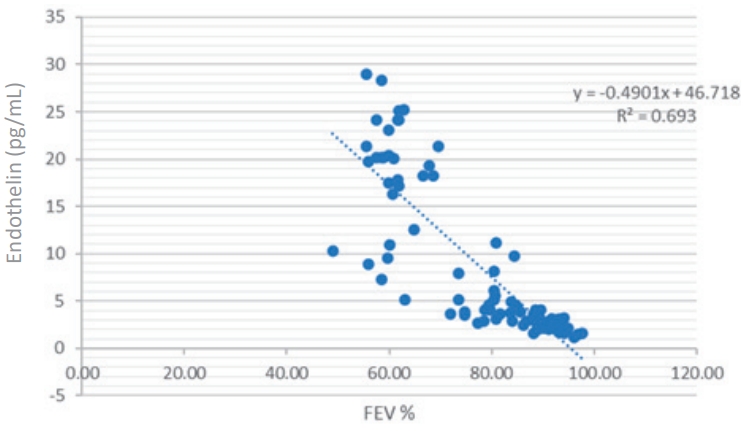
Question: What are the roles of thyroid hormones and endothelin in South Indian children with asthma?
Finding: Thyroid hormone and endothelin levels were significantly elevated in South Indian children with asthma; poorly controlled cases exhibited the highest levels. Elevated thyroid-stimulating hormone and endothelin levels were correlated with asthma severity.
Meaning: Serum endothelin is a potential surrogate marker for asthma severity that could aid the assessment and management of childhood asthma.
- Review Article
- Allergy
- Global burden of asthma among children and adolescents with projections to 2050: a comprehensive review and forecasted modeling study
- Tae Hyeon Kim, Hyunjee Kim, Jiyeon Oh, Soeun Kim, Michael Miligkos, Dong Keon Yon, Nikolaos G Papadopoulos
- Clin Exp Pediatr. 2025;68(5):329-343. Published online April 22, 2025
-

Pediatric asthma can persist to adulthood and must be effectively managed. This review examined the prevalence of asthma among individuals younger than 20 years and revealed a decline from 1990 to 2021, higher rates in males, and a peak in children aged 5–9 years. Despite a projected continued decrease in prevalence by 2050, asthma will remain a significant health concern for children and adolescents.
- Original Article
- Pulmonology
- Nonlinear association between neutrophil-to-lymphocyte ratio and asthma in children and adolescents in the United States: a cross-sectional study
- Chuhan Cheng, Liyan Zhang
- Clin Exp Pediatr. 2025;68(7):489-496. Published online March 11, 2025
-

Question: Is there a nonlinear relationship between neutrophil-to-lymphocyte ratio (NLR) and asthma in children and adolescents?
Finding: NLR showed a nonlinear association with asthma, with an NLR threshold of 2.23 identifying individuals at higher risk.
Meaning: An NLR<2.23 may serve as a potential biomarker for asthma risk assessment and management in pediatric populations, thereby offering a simple tool for the early identification of at-risk individuals.
- Review Article
- Allergy
- Eosinophil-derived neurotoxin levels can predict allergic disease development and atopic march in children
- Zak Callaway, Chang-Keun Kim
- Clin Exp Pediatr. 2025;68(6):398-405. Published online February 3, 2025
-
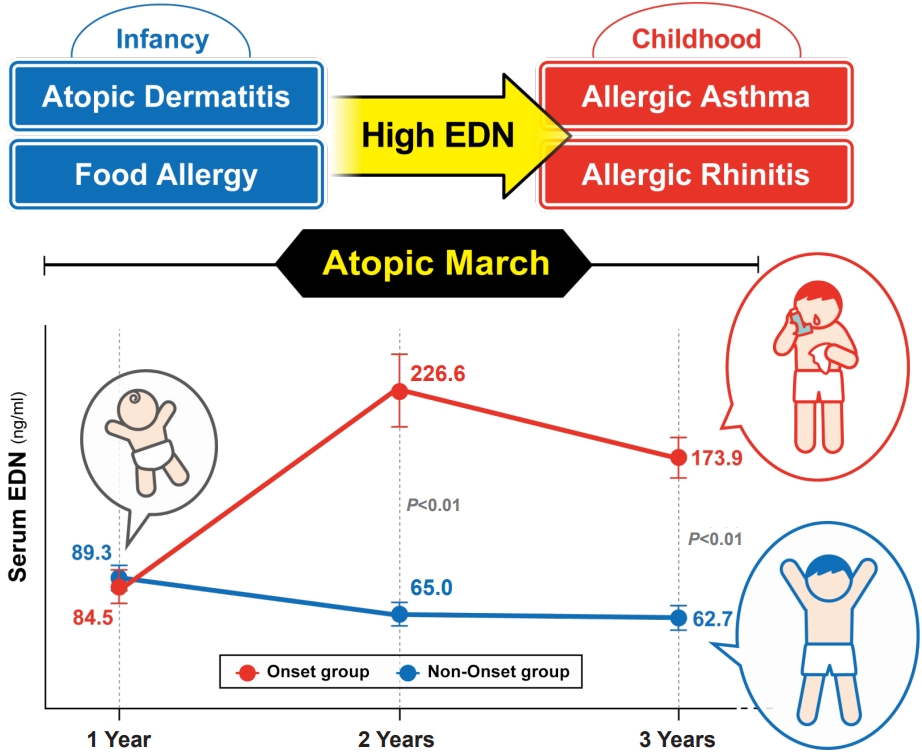
· Allergic march occurs in a subset of children, beginning with atopic dermatitis and progressing to food allergies, allergic rhinitis, and/or asthma. Its early diagnosis is important to slowing its progression.
· Eosinophil-derived neurotoxin (EDN), an excellent biomarker of eosinophil activity, is often elevated in allergic diseases.
· EDN levels have been used to predict allergic disease development and diagnose, treat, and monitor allergic diseases.
- Comparison and review of international guidelines for treating asthma in children
- Eui Jeong Roh
- Clin Exp Pediatr. 2024;67(9):447-455. Published online August 20, 2024
-

Asthma is the most common chronic disease among children. Although asthma in children may spontaneously improve, it continues into adulthood in many cases. Therefore, appropriate disease management and medication are essential. Consistent and objective guidelines are needed to manage pediatric asthma and related adverse reactions.
- Original Article
- Allergy
- Association between dyslipidemia and asthma in children: a systematic review and multicenter cohort study using a common data model
- Ji Eun Lim, Hye Min Kim, Ju Hee Kim, Hey Sung Baek, Man Yong Han
- Clin Exp Pediatr. 2023;66(8):357-365. Published online June 14, 2023
-
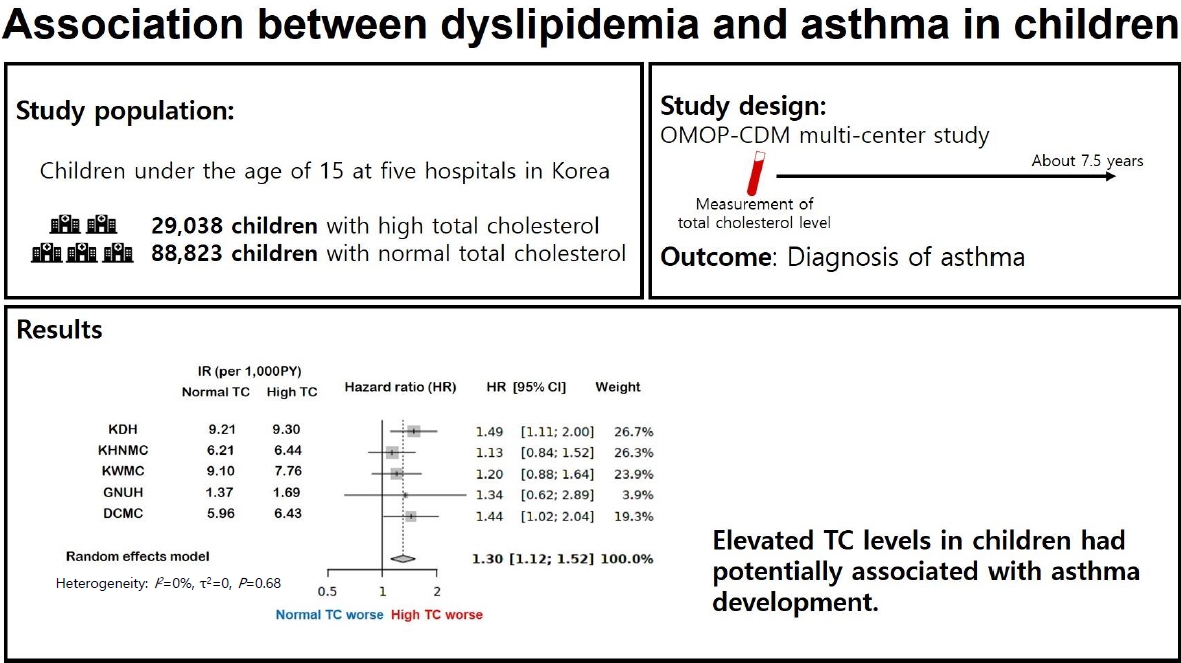
Question: Is dyslipidemia a risk factor for asthma in children?
Finding: This was a comprehensive systematic review and retrospective multicenter study of the association between dyslipidemia and asthma in children. In a multicenter cohort analysis using the Observational Medical Outcomes Partnership Common Data Model, elevated total cholesterol levels were associated with increased risk of asthma development.
Meaning: These findings suggest an association between dyslipidemia and asthma in children.
- Review Article
- Allergy
- Trends of vitamin D in asthma in the pediatric population for two decades: a systematic review
- Myongsoon Sung
- Clin Exp Pediatr. 2023;66(8):339-347. Published online June 14, 2023
-
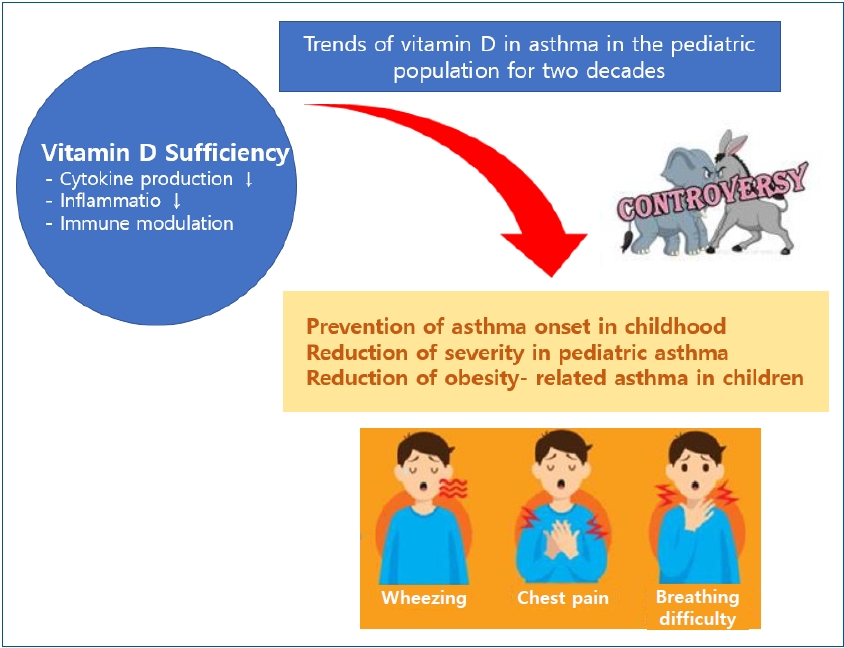
· Vitamin D may affect asthma via multiple mechanisms, including lung and optimal immune system functions.
· Many clinical trials have demonstrated the beneficial effects of vitamin D on asthma onset and aggravation. However, definitive clinical trials are lacking, and reports have detailed contradictory effects of vitamin D in children with asthma.
· Some exciting reports stated that obesity and vitamin D deficiency are associated with increased asthma symptoms in the pediatric population.
- Diagnosis and management of asthma in infants and preschoolers
- Hai Lee Chung
- Clin Exp Pediatr. 2022;65(12):574-584. Published online April 19, 2022
-
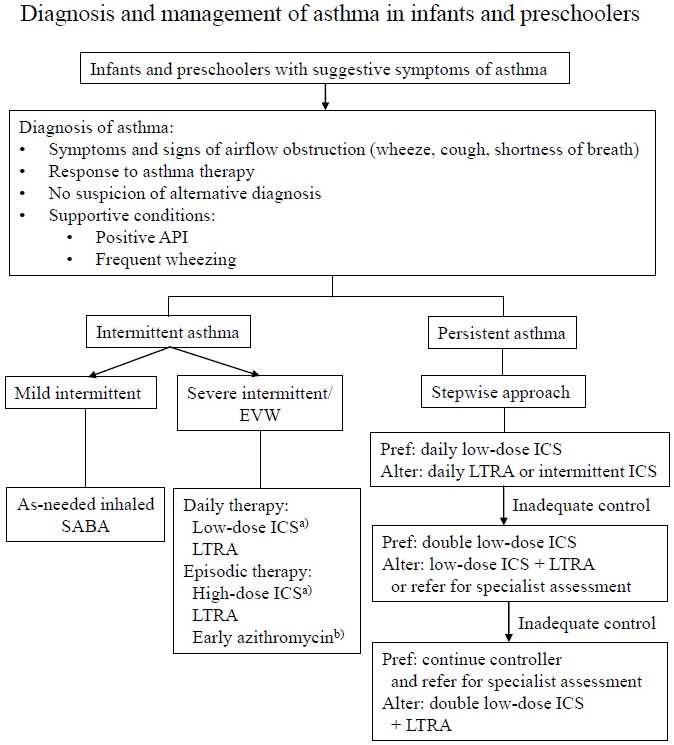
· Asthma in infants and preschoolers involves heterogeneous phenotypes.
· Asthma diagnosis is based on symptom patterns, therapeutic responses, and the presence of risk factors with careful consideration of differential diagnosis.
· Daily inhaled corticosteroid therapy remains the most effective strategy for managing persistent asthma symptoms irrespective of phenotype.
· Future research, including genetic and molecular studies, is needed to develop a clear definition of asthma and personalized therapeutic approaches.
- General Pediatrics
- A new perspective on cholesterol in pediatric health: association of vitamin D metabolism, respiratory diseases, and mental health problems
- Jeana Hong
- Clin Exp Pediatr. 2022;65(2):65-72. Published online December 9, 2021
-
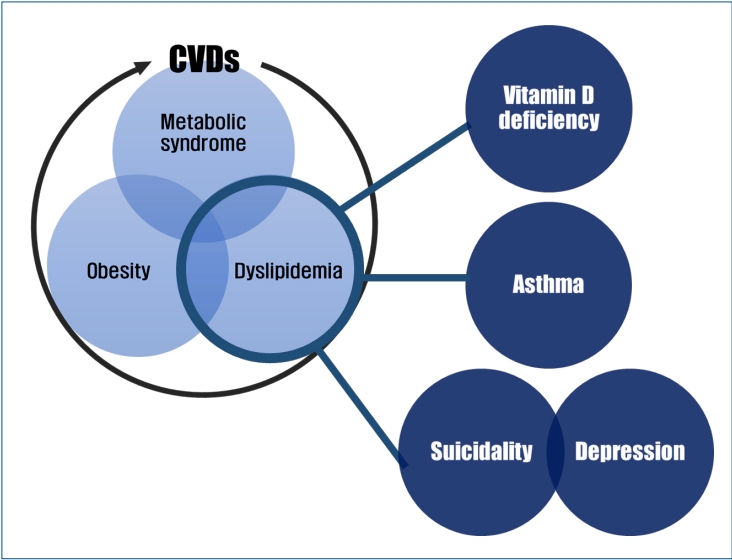
∙ Pediatric dyslipidemia is associated with several health problems besides cardiovascular diseases.
∙ There is a direct association between pediatric dyslipidemia and low serum vitamin D levels, asthma, and mental health problems regardless of body mass index.
∙ More large-scale nationally representative studies are needed to establish the appropriate cutoff points for the definition of dyslipidemia that is a prerequisite for further epidemiological studies in the Korean pediatric population.
- Original Article
- Allergy
- Sex-based differences in factors associated with bronchial hyperresponsiveness in adolescents with childhood asthma
- Young Hwan Kim, Yoon Young Jang, Jieun Jeong, Hai Lee Chung
- Clin Exp Pediatr. 2021;64(5):229-238. Published online January 14, 2021
-
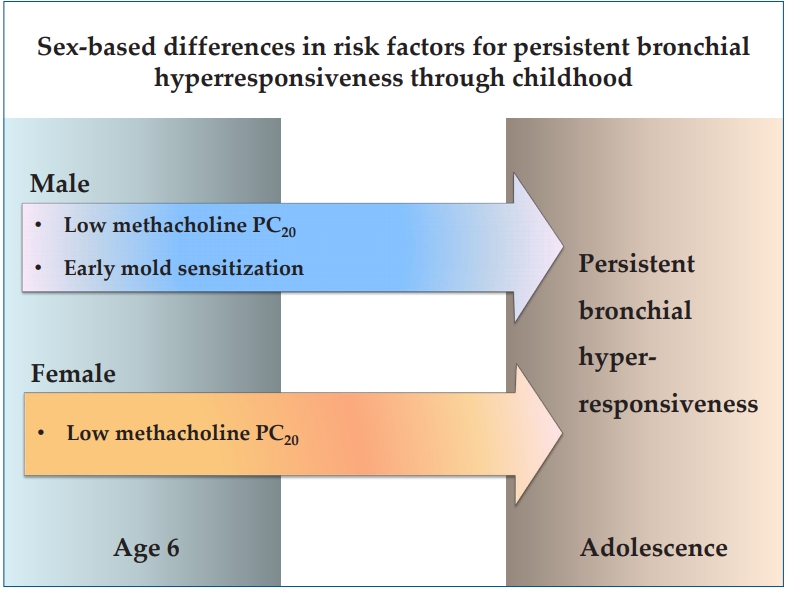
Question: What factors are associated with bronchial hyperresponsiveness (BHR) in adolescents with childhood asthma?
Finding: Age, mold sensitization, and increased eosinophil count were associated with BHR in boys versus a reduced forced expiratory volume in 1 second/forced vital capacity ratio in girls. Early mold sensitization was a risk factor for persistent BHR in boys only.
Meaning: Sex-specific differences were observed in the factors associated with BHR in adolescents.
- Review Article
- Allergy
- Eosinophils and childhood asthma
- Bong Seok Choi
- Clin Exp Pediatr. 2021;64(2):60-67. Published online January 6, 2021
-
•In allergic eosinophilic asthma, eosinophils act as important effector cells and antigen-presenting cells, while in nonallergic eosinophilic asthma, type 2 innate lymphoid cells play an important role in eosinophil activation.
•Sputum eosinophil counts can be helpful for evaluating allergic airway inflammation in asthma.
• Anti-interleukin-5 has broadened the scope of asthma treatment.
- Original Article
- Allergy
- Influence of age at complementary food introduction on the development of asthma and atopic dermatitis in Korean children aged 1–3 years
- Jihyun Lee, Meeyong Shin, Bora Lee
- Clin Exp Pediatr. 2021;64(8):408-414. Published online November 1, 2020
-

Question: Is age at the time of complementary food introduction associated with asthma and atopic dermatitis (AD) in early childhood?
Finding: We found no significant association between age at the time of complementary food introduction and the incidence of AD and asthma in Koreans aged 1–3 years.
Meaning: Our findings suggest that the influence of individual allergenic foods on the development of AD and asthma should be clarified.
- Review Article
- Allergy
- Montelukast use over the past 20 years: monitoring of its effects and safety issues
- Yong Ju Lee, Chang-Keun Kim
- Clin Exp Pediatr. 2020;63(10):376-381. Published online February 5, 2020
-

Although the efficacy of montelukast is inferior to that of ICS, both physicians and parents prefer montelukast to ICSs.
EDN may be a useful biomarker for the treatment and monitoring of preschool children with asthma.
The US FDA requires boxed warning about serious neuropsychiatric events of montelukast, therefore, physicians should consider the benefits and risks of montelukast before prescribing it.
- Original Article
- Allergy
- Ten-year trends and prevalence of asthma, allergic rhinitis, and atopic dermatitis among the Korean population, 2008–2017
- Jihyun Ha, Seung Won Lee, Dong Keon Yon
- Clin Exp Pediatr. 2020;63(7):278-283. Published online January 29, 2020
-
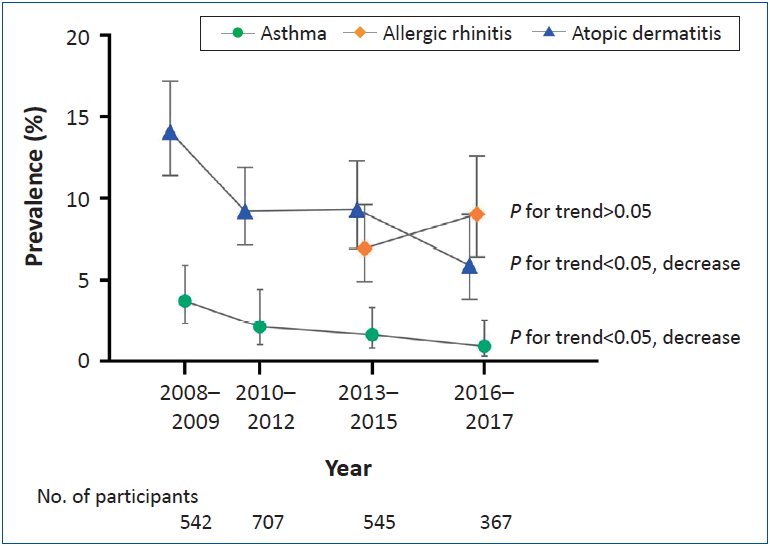
Background: Major questions remain regarding the agestratified trends of allergic diseases and asthma in Korea.
Purpose: To identify the estimated recent prevalence and 10- year trends in asthma, allergic rhinitis, and atopic dermatitis among the Korean population from 2008 to 2017. Methods: This nationwide cross-sectional survey (Korean National Health and Nutrition Examination Survey) over 10 years (2008–2017) examined representative samples of the...
- Asthma predictive index as a useful diagnostic tool in preschool children: a cross-sectional study in Korea
- Dong Hyeon Lee, Ji-Won Kwon, Hyung Young Kim, Ju-Hee Seo, Hyo-Bin Kim, So-Yeon Lee, Gwang-Cheon Jang, Dae-Jin Song, Woo Kyung Kim, Young-Ho Jung, Soo-Jong Hong, Jung Yeon Shim
- Clin Exp Pediatr. 2020;63(3):104-109. Published online November 8, 2019
-

Question: Is physician-diagnosed current asthma in preschool children associated with the asthma predictive index, atopic sensitization, or pulmonary function test?
Finding: Physician-diagnosed current asthma in preschool children was associated with the asthma predictive index, but not with spirometry, methacholine provocation test, fractional expiratory nitric oxide level, and atopic sensitization.
Meaning: Physician-diagnosed asthma in preschool children may be different from classic atopic asthma in school children or adolescents.
- Review Article
- Allergy
- Particulate matter and childhood allergic diseases
- Song-I Yang
- Clin Exp Pediatr. 2019;62(1):22-29. Published online November 7, 2018
-
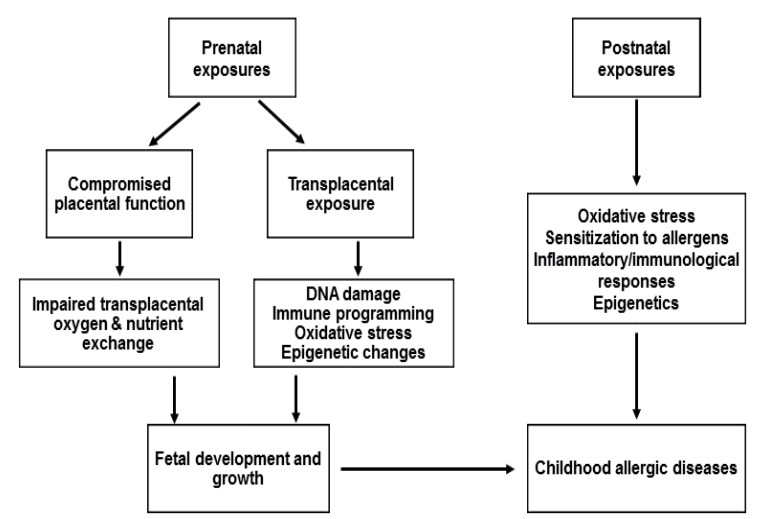
Particulate matter (PM) is a ubiquitous air pollutant that is a growing public health concern. Previous studies have suggested that PM is associated with asthma development and exacerbation of asthma symptoms. Although several studies have suggested increased risks of atopic dermatitis, allergic rhinitis, and allergic sensitization in relation to PM exposure, the evidence remains inconsistent. The plausible mechanisms underlying these...
- Original Article
- Allergy
- Accuracy of maximal expiratory flow-volume curve curvilinearity and fractional exhaled nitric oxide for detection of children with atopic asthma
- Sang Hoo Park, Min Ji Im, Sang-Yong Eom, Youn-Soo Hahn
- Clin Exp Pediatr. 2017;60(9):290-295. Published online September 21, 2017
-
Purpose Airway pathology in children with atopic asthma can be reflected by the concave shape of the maximal expiratory flow-volume (MEFV) curve and high fractional exhaled nitric oxide (FeNO) values. We evaluated the capacity of the curvilinearity of the MEFV curve, FeNO, and their combination to distinguish subjects with atopic asthma from healthy individuals.
Methods FeNO and angle β, which characterizes the general...
- Review Article
- Allergy
- Rhinovirus and childhood asthma: an update
- Dae Jin Song
- Clin Exp Pediatr. 2016;59(11):432-439. Published online November 18, 2016
-
Asthma is recognized as a complex disease resulting from interactions between multiple genetic and environmental factors. Accumulating evidence suggests that respiratory viral infections in early life constitute a major environmental risk factor for the development of childhood asthma. Respiratory viral infections have also been recognized as the most common cause of asthma exacerbation. The advent of molecular diagnostics to detect...
- Impact of perinatal environmental tobacco smoke on the development of childhood allergic diseases
- Hyeon-Jong Yang
- Clin Exp Pediatr. 2016;59(8):319-327. Published online August 24, 2016
-
Allergic diseases such as asthma, allergic rhinitis, atopic dermatitis, and food allergy, are most common chronic, noncommunicable diseases in childhood. In the past few decades, the prevalence has increased abruptly worldwide. There are 2 possible explanations for the rising prevalence of allergic diseases worldwide, that an increased disease-awareness of physician, patient, or caregivers, and an abrupt exposure to unknown hazards....
- Case Report
- Genetics and Metabolism
- A rare case of Sjogren-Larsson syndrome with recurrent pneumonia and asthma
- Azita Tavasoli, Shirin Sayyahfar, Babak Behnam
- Clin Exp Pediatr. 2016;59(6):276-279. Published online June 30, 2016
-
Sjogren-Larsson syndrome (SLS) is a rare autosomal recessive neurocutaneous disorder with worldwide incidence of 0.4 per 100,000 people. It is characterized by the triad of congenital ichthyosis, spastic diplegia or quadriplegia, and mental retardation. Herein we report a 2-year-old male child with SLS, asthma, and recurrent pneumonia. SLS was confirmed by a molecular genetics study that revealed a deletion mutation...
- Original Article
- Allergy
- The relationships among birth season, sunlight exposure during infancy, and allergic disease
- Jung Min Hwang, Se Hyun Oh, Mee Yong Shin
- Clin Exp Pediatr. 2016;59(5):218-225. Published online May 31, 2016
-
Purpose The recent increase in the prevalence of allergic diseases is hypothetically attributed to immune dysregulation in turn caused by a reduction in exposure to sunlight. We explored relationships between birth season, sunlight exposure, exercise duration, and an allergic disease.
Methods We performed a questionnaire-based survey on allergic diseases among elementary school students. Birth time was categorized according to the season (summer and...
- High degree of supervision improves adherence to inhaled corticosteroids in children with asthma
- Geun Mi Park, Hye Won Han, Hee Se Kim, Jae Youn Kim, Eun Lee, Hyun-Ju Cho, Song-I Yang, Young-Ho Jung, Soo-Jong Hong, Hyung Young Kim, Ju-Hee Seo, Jinho Yu
- Clin Exp Pediatr. 2015;58(12):472-477. Published online December 22, 2015
-
Purpose Adherence to treatment with inhaled corticosteroids (ICS) is a critical determinant of asthma control. The objective of this study was to assess factors that determine adherence to ICS therapy in children with asthma.
Methods Fifty-eight children with asthma, aged 5 to 16 years, used ICS with or without a spacer for 3 months. Adherence rates as measured from questionnaires and canisters, asthma...
- Case Report
- Case of seropositive allergic bronchopulmonary aspergillosis in a 10-year-old girl without previously documented asthma
- Jeong Eun Shin, Jae Won Shim, Deok Soo Kim, Hae Lim Jung, Moon Soo Park, Jung Yeon Shim
- Clin Exp Pediatr. 2015;58(5):190-193. Published online May 22, 2015
-
Allergic bronchopulmonary aspergillosis (ABPA) is a hypersensitivity lung disease due to bronchial colonization of
Aspergillus fumigatus that occurs in susceptible patients with asthma or cystic fibrosis. A 10-year-old girl was referred to the Department of Pediatric Pulmonology for persistent consolidations on chest radiography. Pulmonary consolidations were observed in the right upper and left lower lobes and were not resolved with...
- Original Article
- House dust mite-specific immunoglobulin E and longitudinal exhaled nitric oxide measurements in children with atopic asthma
- Youn Kyung Lee, Sohyoung Yang, Joohyun Park, Heon Kim, Youn-Soo Hahn
- Clin Exp Pediatr. 2015;58(3):89-95. Published online March 20, 2015
-
Purpose House dust mite (HDM) has been suggested to be the most important aeroallergen responsible for atopic asthma in Korea. We aimed to investigate that specific IgE antibodies to HDM and other common indoor aeroallergens contribute differently to total serum IgE and show different relationships with longitudinal fractional exhaled nitric oxide (FeNO) measurements in Korean atopic asthmatic patients.
Methods A total of 193...
- Increased risk of refractory
Mycoplasma pneumoniae pneumonia in children with atopic sensitization and asthma - Jeong Eun Shin, Bo Ram Cheon, Jae Won Shim, Deok Soo Kim, Hae Lim Jung, Moon Soo Park, Jung Yeon Shim
- Clin Exp Pediatr. 2014;57(6):271-277. Published online June 30, 2014
-
Purpose A nationwide outbreak of
Mycoplasma pneumoniae pneumonia (MP) refractory to macrolide antibiotics occurred in Korea during 2011. Steroid therapy has been reported to be both efficacious and well tolerated in pediatric patients with refractory MP. We compared clinical features and laboratory characteristics between children with refractory MP requiring steroid treatment and those with macrolide-responsive MP and evaluated the risk factors...
- Prevalence of respiratory viral infection in children hospitalized for acute lower respiratory tract diseases, and association of rhinovirus and influenza virus with asthma exacerbations
- Jang-Mi Kwon, Jae Won Shim, Deok Soo Kim, Hye Lim Jung, Moon Soo Park, Jung Yeon Shim
- Clin Exp Pediatr. 2014;57(1):29-34. Published online January 31, 2014
-
Purpose In this study, we aimed to investigate the prevalence of year-round respiratory viral infection in children with lower respiratory tract infection (LRTI) and the relationship between respiratory viral infection and allergen sensitization in exacerbating asthma.
Methods We investigated the sources for acute LRTIs in children admitted to our hospital from May 2010 to April 2011. The 6 most common respiratory viruses were...
- The effect of rhinovirus on airway inflammation in a murine asthma model
- Eugene Kim, Huisu Lee, Hyun Sook Kim, Sulmui Won, Eu Kyoung Lee, Hwan Soo Kim, Kyongwon Bang, Yoon Hong Chun, Jong-Seo Yoon, Hyun Hee Kim, Jin Tack Kim, Joon Sung Lee
- Clin Exp Pediatr. 2013;56(11):482-489. Published online November 27, 2013
-
Purpose The aim of the present study was to investigate the differences in lower airway inflammatory immune responses, including cellular responses and responses in terms of inflammatory mediators in bronchoalveolar lavage fluid (BALF) and the airway, to rhinovirus (RV) infection on asthma exacerbation by comparing a control and a murine asthma model, with or without RV infection.
Methods BALB/c mice were intraperitoneally injected...
- Review Article
- Measurements of fractional exhaled nitric oxide in pediatric asthma
- Youn-Soo Hahn
- Clin Exp Pediatr. 2013;56(10):424-430. Published online October 31, 2013
-
Exhaled nitric oxide (NO) has been extensively investigated as a noninvasive marker of airway inflammation in asthma. The increased NO expression induced by inflammatory mediators in airways can be monitored easily in exhaled air from asthmatic children. Based on the relationship between the increased NO expression and eosinophilic airway inflammation, fractional exhaled nitric oxide (FeNO) measurements become an important adjunct...
- Original Article
- Prevalence and comorbidity of allergic diseases in preschool children
- Hyeong Yun Kim, Eun Byul Kwon, Ji Hyeon Baek, Youn Ho Shin, Hye Yung Yum, Hye Mi Jee, Jung Won Yoon, Man Yong Han
- Clin Exp Pediatr. 2013;56(8):338-342. Published online August 27, 2013
-
Purpose Allergic disease and its comorbidities significantly influence the quality of life. Although the comorbidities of allergic diseases are well described in adult populations, little is known about them in preschool children. In the present study, we aimed to assess the prevalence and comorbidity of allergic diseases in Korean preschool children.
Methods We conducted a cross-sectional study comprising 615 Korean children (age, 3...
- Review Article
- Phenotypes and endotypes of severe asthma in children
- Young Yoo
- Clin Exp Pediatr. 2013;56(5):191-195. Published online May 28, 2013
-
Severe childhood asthma is a complicated and heterogeneous disorder with distinct phenotypes. Children with severe asthma have more persistent symptoms despite receiving treatment, more atopy, greater airway obstruction, and more air trapping than those with mild-to-moderate asthma. They also have higher morbidity and substantial airflow limitations that persist throughout adulthood. Identification of the phenotype clusters and endotypes of severe asthma...
-

-
-
6.02024CiteScore98th percentilePowered by
-
Impact Factor3.6
-
- TOPICS
- ARTICLE CATEGORY
- Editorial Office
-
Korean Pediatric Society
#1606 Seocho World Officetel, 19 Seoun-ro, Seocho-ku, Seoul 06732, Korea
Tel: +82-2-3473-7306 Fax: +82-2-3473-7307 E-mail: office@e-cep.org
Clinical and Experimental Pediatrics is an open access journal. All articles are distributed under the terms of the Creative Commons Attribution NonCommercial License (http://creativecommons.org/licenses/by-nc/4.0/)
Copyright © 2025 by Korean Pediatric Society.











